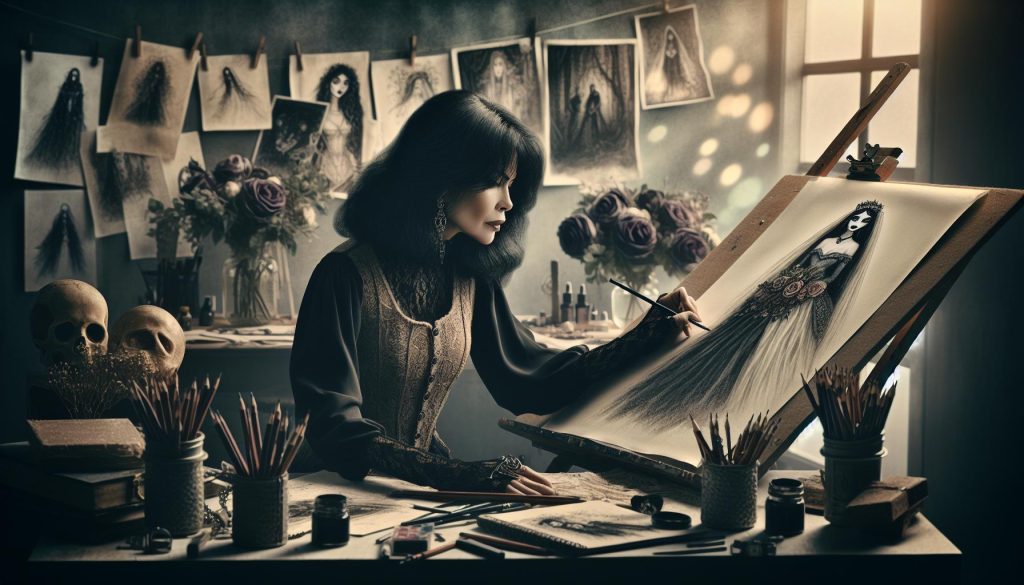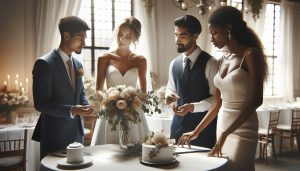Imagine the magic of a wedding that transcends time and embraces the ethereal beauty of love that lasts beyond the grave. “How to Draw Corpse Bride – Gothic Wedding Illustrations” invites you into a whimsical world where gothic aesthetics meet romantic storytelling. Whether you’re a budding artist or a Bride-to-Be inspired by Tim Burton’s enchanting tale, this guide will help you craft stunning illustrations that capture the essence of an otherworldly celebration. You’ll discover techniques to master the graceful details of this iconic character while exploring how to blend traditional wedding elements with a unique gothic twist. Join us as we delve into this artistic journey, igniting your creativity and passion for all things wedding-related. Prepare to transform your vision into reality and bring your gothic wedding fantasies to life!
Understanding the Aesthetic of Corpse Bride Illustrations
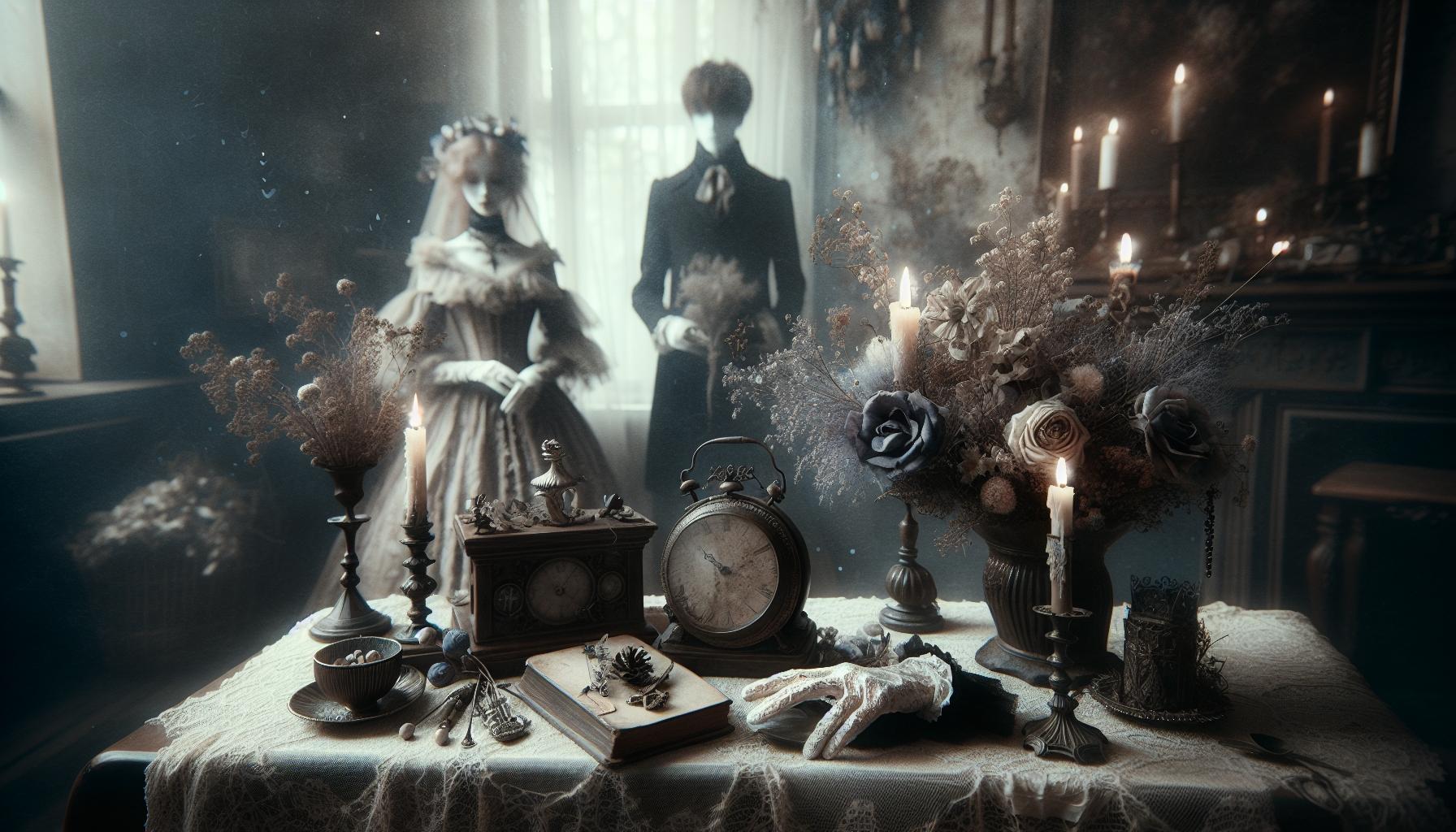
The unique aesthetic of Corpse Bride illustrations marries the macabre with the romantic, creating a captivating visual narrative that invites the viewer into a world where love transcends even death. Richly detailed and filled with emotion, these illustrations draw heavily on Gothic themes, evoking a sense of nostalgia and a whimsical eeriness. Tim Burton’s classic film serves as a profound source of inspiration, showcasing a palette characterized by muted colors and haunting contrasts that breathe life into the undead. The aesthetics often reflect themes of longing, melancholy, and the bittersweet nature of love, resonating deeply with those who appreciate Gothic art.
To effectively channel this aesthetic in your own illustrations, consider focusing on key elements such as exaggerated features and stylized forms. Characters like Emily, the Corpse Bride, are often depicted with elongated limbs, expressive eyes, and intricate detailing in their attire. The use of patterns and textures can enhance this jangling beauty; think lace, frayed edges, and rich fabrics that evoke a sense of both elegance and decay. Incorporating elements like wilted flowers, tattered veils, or rusted jewelry can also add layers of meaning, emphasizing the tension between love and loss.
For artists eager to immerse themselves in this aesthetic, it’s essential to be mindful of color choices. Shadows play a crucial role in creating depth and drama. Opt for deep blacks, dusky blues, and occasional pops of vibrancy to represent moments of joy or clarity amidst sadness. Pay attention to light sources and how they interact with shadows to mold your characters and settings, as this will help instill a sense of life-even in a world where the characters are no longer living.
Ultimately, the goal of mastering the Corpse Bride aesthetic is not simply to replicate a style but to convey profound emotions and narratives through your artwork. By blending elements of romance, sorrow, and whimsical charm in your illustrations, you can create a truly enchanting piece that captures the essence of this Gothic fairy tale.
Essential Materials for Drawing Gothic Characters
To bring your Gothic characters to life, especially those inspired by the captivating world of *Corpse Bride*, curating the right materials can make all the difference. Artists looking to capture the intricate details and emotions of these figures should consider a range of essential tools that enhance both form and expression.
Begin with a sturdy but flexible sketchbook that can withstand various mediums, such as a watercolor or mixed media pad. This will allow you to explore different techniques as you develop your illustrations. For sketching initial outlines, opt for a high-quality graphite pencil set, which provides a range of hardness levels to achieve fine lines and textured shading. Layering with colored pencils or pastels can also add depth to your creations, allowing you to blend and play with hues reminiscent of an autumn evening.
When it comes to inking your illustrations, consider using fine liners or brush pens. These tools provide versatility: thinner points are perfect for detailed sections like lace dresses or expressive facial features, while brush pens can create dynamic, sweeping lines for flowing hair or suggest movement. Adding a selection of water-based markers can also bring in vibrant pops of color without overwhelming the gothic aesthetic.
Color Choices and Paper Types
Choosing the correct color palette is essential. For a *Corpse Bride* appeal, deep tones like midnight blue, forest green, and rich purples paired with soft pastels can evoke the eerie yet romantic mood characteristic of Gothic art. To ensure your colors reflect their true vibrancy, perform tests on various types of paper. Watercolor paper works wonderfully for mixed media, allowing you to layer without warping, while smoother papers are better for detailed ink work.
Other treasures worth adding to your toolkit include blending stumps for smooth transitions in shading and an eraser stick for precise corrections. Don’t forget to incorporate textures; fabrics, lace patterns, and aged materials can inspire your character clothing or backgrounds. These details will help convey the unique essence of your Gothic illustrations, making your characters feel both enchanting and authentic.
In essence, your materials should not only aid the creation of visually stunning illustrations but should also resonate with the emotional depth of the characters within them. By equipping yourself with high-quality tools and thoughtfully selected colors, you will be well-prepared to embark on your artistic journey into the haunting world of *Corpse Bride*.
Step-by-Step Guide to Sketching Corpse Bride
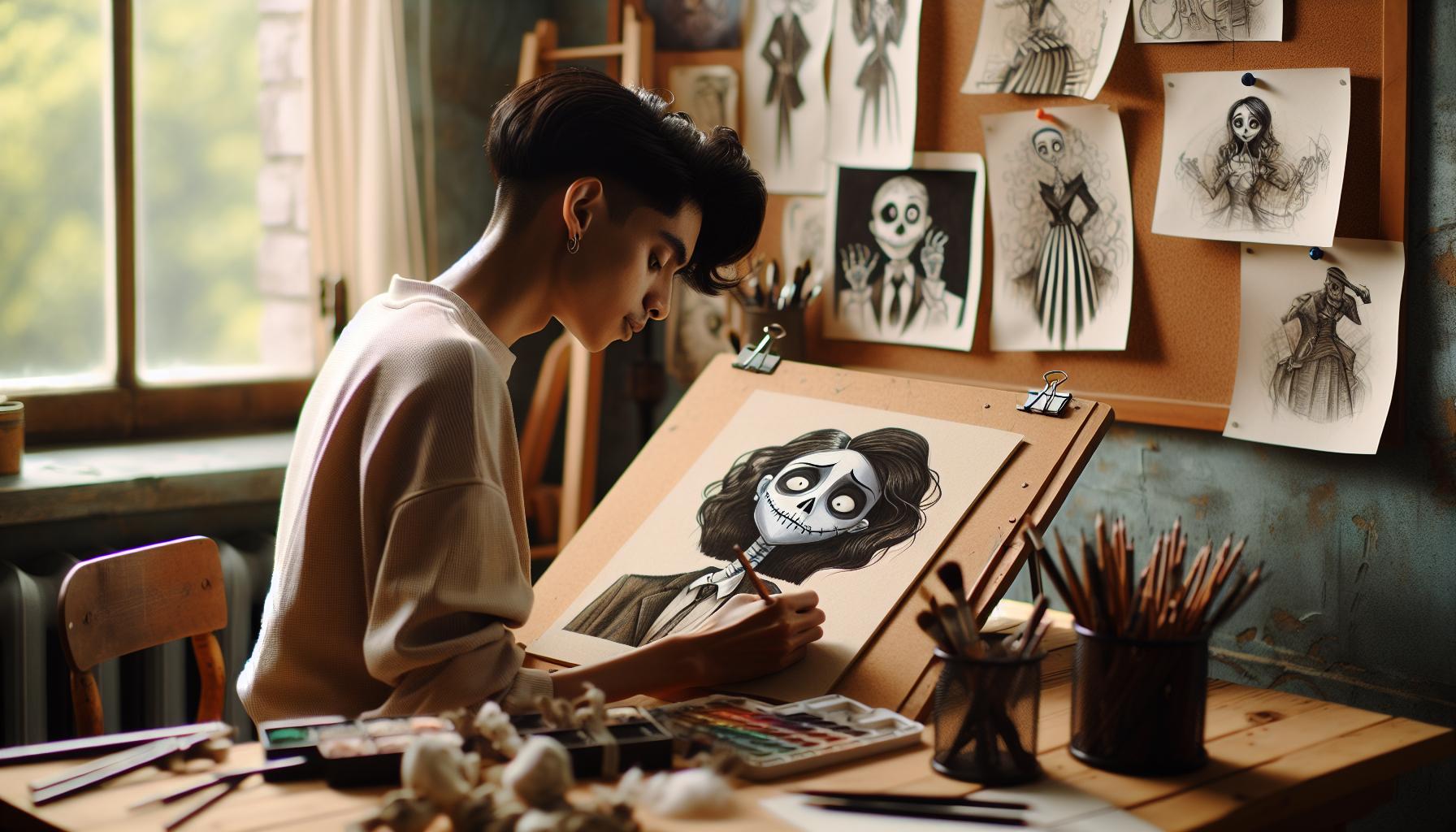
To bring the enchanting character of the Corpse Bride to life on paper, it’s essential to approach your sketching process thoughtfully and with a keen eye for detail. Begin by collecting visual references, including stills from the film, artwork, and Gothic influences that resonate with the mood you wish to convey. Consider the elements that make the Corpse Bride unique, such as her ethereal appearance, detailed attire, and emotive expressions. These aspects will serve as guiding stars in your creative journey.
Start your drawing with a light pencil sketch to outline the basic shapes and proportions of the Corpse Bride. Focus on the overall silhouette, capturing the grace and elegance that defines her character. Use simple geometric shapes to block in her form-ovals for the head and body, and circles for the joints. This technique helps establish the correct posture and proportions before diving into the intricate details of her face and gown.
Once the foundation is set, intricately render her features-pay close attention to her expressive eyes, delicate lips, and the flowing hair that adds movement to the composition. It may be helpful to look at different expressions to convey the right emotion, whether it’s melancholy or joy. As you refine the face, incorporate delicate details such as eyelashes and the unique contours of her cheekbones to enhance her haunting beauty.
Detailing the Attire
When sketching the gown, emphasize the flowing fabric with gentle, sweeping lines that suggest movement. Consider using reference images of lace and frills, carefully observing how light interacts with different textures. To create depth, add subtle folds and creases where the material gathers, which will bring realism to the illustration. Remember, the attire should reflect her ghostly elegance-play with both the intricate designs and the soft curves that characterize the Gothic style.
As you move toward finalizing your sketch, contemplate the background elements that could complement your character. A moonlit graveyard, twisted trees, or ethereal flowers can enhance the atmosphere surrounding your Corpse Bride. Keep your lines soft and flowing to maintain the hauntingly romantic essence of the character as you incorporate these surroundings. With patience and practice, you will capture the enchanting world of the *Corpse Bride*, creating an illustration that tells a story of its own.
Mastering Color Palettes for Gothic Art
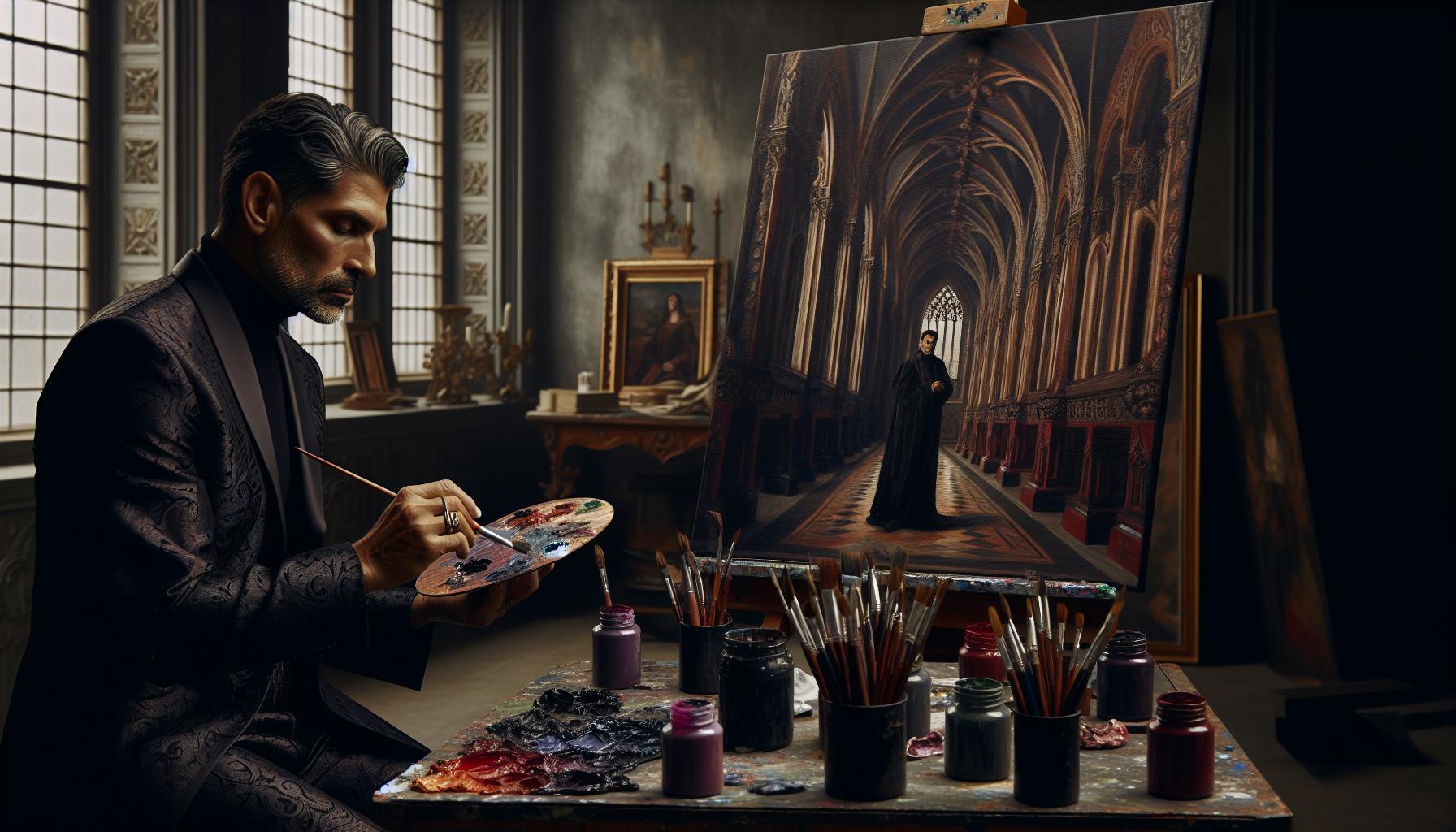
Mastering color palettes can make or break your Gothic illustrations, particularly when bringing a character like the Corpse Bride to life. The right colors enhance the ethereal quality of your work, evoke emotion, and create a fitting atmosphere for your Gothic themes. When crafting your palette, focus on a range that reflects the melancholic beauty of the character and setting, harmonizing darker shades with softer, ghostly tones that suggest both elegance and mystery.
Begin with a foundational palette that captures the essence of Gothic aesthetics. Consider using shades such as deep purples, midnight blues, and rich blacks as your base. These colors convey depth and darkness, perfect for a character steeped in melancholy. To counterbalance these darker hues, incorporate lighter colors such as soft grays, pale whites, and muted pastels-especially in the clothing and background details-to suggest the Corpse Bride’s ethereal quality.
Another approach involves utilizing contrasting colors to highlight emotions and elements in your illustration. For example, a pop of crimson or vibrant emerald can symbolize love and life, bringing a stark contrast against cooler tones. Layering these colors can add emotion-consider using translucent washes or blended gradients for a ghostly effect. An excellent technique is to apply subtle color variations to the shadows and highlights, reinforcing the depth and dimensionality of your character.
Consider the overall composition; the colors should guide the viewer’s eye and enhance the story you wish to tell. In your background, muted colors like grays and browns can help the central figure stand out. You might also explore color theory and complementary colors to enhance the mood. For instance, pairing warm and cool colors can create striking visuals that capture attention and evoke the eerie yet beautiful essence of the Corpse Bride.
Finally, remember that color palettes are not static; feel free to experiment and adjust as you go. Use swatches to test different combinations and see how they interact on paper. A well-thought-out palette will not only breathe life into your illustrations but also resonate emotionally with anyone who views your work, making your Gothic art truly captivating.
Creating Dramatic Depth with Shadows and Highlights
In the world of Gothic illustrations, creating a sense of depth is crucial for bringing characters like the Corpse Bride to life. Shadows and highlights are not just decorative elements; they can evoke emotion and set the tone for your artwork. Mastering these techniques allows you to enhance the three-dimensional quality of your illustrations, drawing viewers into the ethereal world you are depicting.
To create depth, start by establishing a light source in your composition. This will guide where shadows and highlights should fall, giving your character a coherent form. Use a range of tones to depict the contrasting effects of light and shadow. For the Corpse Bride, consider using darker hues for shadowed areas, such as the folds of her dress, the contours of her face, and beneath her chin. You can employ deep blues or purples for the shadows, reinforcing the melancholic atmosphere inherent to her character. Highlights, on the other hand, could be subtle applications of soft whites or pale lavenders to bring attention to her glowing features, like her eyes or hair, suggesting an otherworldly presence.
Layering is another effective technique to achieve dramatic depth. Apply multiple layers of shadows and highlights, gradually building up the intensity. Begin with a base tone and then add darker shades in specific areas, blending them softly to avoid harsh lines. Subsequently, layer lighter colors for highlights, ensuring they seamlessly blend into the shadows to suggest volume. A soft brush or blending tool can help in achieving this gradual transition, which is essential for the ethereal feel of Gothic art. Remember, less is often more; subtle variations can create a more believable effect than stark contrasts.
Consider also the texture of your materials, as different media can affect how shadows and highlights appear. For instance, with colored pencils, varying the pressure can shift the intensity of the colors you apply, allowing you to create softer, blended transitions. Acrylics and watercolors offer the ability to build layers, enabling you to fine-tune the depth at your whim. Always step back from your piece periodically to assess the overall impact of your shadows and highlights, adjusting as necessary to maintain the visual harmony of your illustration.
By skillfully incorporating shadows and highlights, you not only create depth but also weave a captivating narrative within your artwork, guiding the viewer’s emotions through the atmospheric embrace of your Gothic illustration.
Incorporating Gothic Elements into Your Artwork
To create captivating Gothic illustrations that embody the ethereal charm of the Corpse Bride, it is essential to incorporate elements that evoke a sense of romance, mystery, and timelessness. Gothic art thrives on contrasts-light and dark, love and loss-and integrating these nuances into your artwork allows your creations to resonate deeply with viewers. Think about how the elements you include can enhance the narrative of your illustration.
One way to embrace Gothic themes is through architecture and background elements. Incorporate elements like crumbling stone walls, towering church spires, or even a moonlit graveyard to ground your characters in a uniquely Gothic landscape. These settings not only serve as backdrops but also enrich the storytelling aspect of your illustrations, inviting viewers to delve into the world you have crafted. Remember to use rich, opulent details that reflect the grandeur of Gothic architecture, like intricate patterns that adorn the embraces of gothic arches or the lace-like quality of wrought iron.
Flowing, whimsical fabrics can also play a crucial role in creating a Gothic ambiance. The Corpse Bride herself could be depicted in tattered lace, flowing veils, or layered textures that suggest a mingling of grace and decay. When illustrating garments, consider how movement can convey emotion; swirling fabrics can symbolize longing or nostalgia, mirroring the emotional depth of your subject. Utilize color palettes that highlight this contrast; muted shades mixed with splashes of vibrant colors can invoke feelings of both beauty and eeriness.
Textures are paramount in achieving the ethereal quality often found in Gothic art. Experiment with various media to portray physical characteristics thoughtfully. For instance, using soft pastel for delicate skin tones versus rough charcoal for textural contrasts can add dimensionality to your work. Shimmering metallics can be subtly woven into details like jewelry or hair accents, suggesting a hint of gravitas and drama reflective of the emotions tied to the Gothic romance.
Finally, consider the incorporation of symbolic elements such as roses, skulls, or ravens. These symbols can subtly convey themes of love, mortality, or transformation, deepening the visual storytelling within your illustrations. By thoughtfully infusing these Gothic elements into your artwork, you create a multi-layered narrative that not only honors the spirit of the Corpse Bride but also captivates viewers with its depth and beauty.
Character Design: Building Your Own Corpse Bride
Creating your own interpretation of the Corpse Bride allows you to explore the delicate interplay of light and shadow, love and loss, in a character that embodies both beauty and melancholy. Begin by imagining the essence of the character you wish to portray; is she a tragic figure imbued with longing, or a whimsical spirit dancing between realms? Let your artistic vision guide you to develop her most distinctive features, helping to convey her narrative through visual elements that resonate with the viewer.
To craft a compelling design, focus on the shape and structure of her silhouette. Consider using elegant lines that accentuate her form, creating a flowing appearance reminiscent of bridal attire. A classic gown can be designed with layers of tattered lace and flowing veils that symbolize her ethereal nature and connection to the past. Think about incorporating asymmetry in her outfit to imply movement and life, even amidst her ghostly demeanor. Use dramatic fabric draping to evoke an emotional response, choosing rich textures that suggest both grace and decay.
The color palette plays a crucial role in character design. Utilize muted shades of gray, blue, and hints of faded pastels, which can evoke a sense of nostalgia while also emphasizing the Gothic aesthetic. To add depth, consider integrating contrasting colors like dark purples or blacks in her accessories or background elements, highlighting the duality of her existence. Pay attention to the symbolic use of colors-soft whites may represent purity, while darker hues may hint at her tragic backstory.
Finally, details are what can truly bring your Corpse Bride to life. Add unique touches such as floral motifs, perhaps incorporating wilted roses or ivy creeping along her dress to symbolize love entwined with loss. Facial features can be crafted to exhibit both allure and sorrow, enhancing her depth through expressive eyes and delicate features that reflect her story. Every element you design should echo a narrative, inviting viewers to engage with her journey and explore the emotional layers woven throughout your illustration. As you build your character, remember that she is not just a bride of death, but a symbol of love that transcends even the darkest of circumstances.
Adding Personal Touches: Customizing Your Drawings
To breathe life into your artistic interpretation of the Corpse Bride, it’s essential to customize your drawings with unique personal touches that reflect both your style and your emotional connection to the character. Each artistic decision creates an opportunity to tell a deeper story, inviting viewers to resonate with the essence of your vision. You can start by infusing elements that depict her backstory-does she have a favorite flower associated with a memory? Integrate delicate petals or a specific color motif that captures her spirit and personal narrative.
Consider adding intricate details to her attire that signify something more than mere decoration. For instance, you might choose to embellish her gown with symbols that represent her journey-perhaps a lace trim that mimics the waves of the sea if her story ties to aquatic themes or a series of tiny charms attached to her veil that tell the tale of her love life. Including such meaningful aspects not only personalizes your work but also transforms it into a heartfelt tribute that speaks volumes about her character and experiences.
Color choices play a crucial role in setting the tone of your illustration. Don’t hesitate to experiment with unexpected color palettes that reflect your individual tastes while still adhering to the Gothic theme. Mixing classic muted tones with vibrant accents can bring dynamism to your artwork. For instance, if your Corpse Bride expresses a whimsical side, consider splashes of bright colors like teal or lavender amidst the iconic grays and blacks. These choices resonate emotionally, emphasizing her juxtaposition of life and death while showing how styles can diverge and blend harmoniously.
Finally, remember that the character’s expression is vital in communicating her story to the world. Carefully sculpt her facial features to elicit emotions that align with her narrative. Whether it’s shimmering eyes that reflect sorrow or an enigmatic smile that hints at secrets untold, subtle alterations can profoundly affect viewers’ connection to her. Art is not just about replicating forms; it’s about evoking feelings and exploring the stories we all share. Embrace this opportunity to make your Corpse Bride truly your own, ensuring every stroke brings you closer to the character and the story you wish to tell.
Techniques for Bringing Emotion to Gothic Illustrations
To convey deep emotion in Gothic illustrations such as those inspired by the Corpse Bride, artists must master a blend of techniques that resonate with the viewer’s psyche. Gothic art often dwells in the interplay between life and death, light and shadow, happiness and sorrow. This duality allows for rich storytelling through visuals, making the characters not just figures but carriers of emotion.
One effective method to evoke emotion is through the character’s facial expressions. Subtle variations in the eyes, mouth, and overall posture can communicate complex feelings. For instance, a slight downturn of the lips or a wistful gaze can suggest longing or sadness, while bright, wide eyes may evoke surprise or joy. Details matter; consider how the character’s eyeliner or the shape of her eyebrows can enhance the emotional atmosphere of your piece.
Incorporating symbolic elements into your illustrations can also add layers of meaning. Elements such as color, clothing, or background details can serve as metaphors for the character’s emotional state. For example, soft, flowing fabrics can represent fragility and beauty, while sharp, jagged shapes could emphasize conflict or despair. Use colors thoughtfully: deep reds might signify passion or anger, while muted grays can evoke melancholy.
Additionally, the use of light and shadow is crucial in creating emotional depth. High contrast between stark light and dark shadows can highlight certain features of your character, making them appear more dramatic. A softly lit area could invite warmth and intimacy, while harsh shadows might enhance feelings of despair or isolation. Mastery of this technique can transform simple portraits into evocative narratives that draw the viewer in.
Combining these techniques and allowing your personal style to shine through will result in illustrations that not only capture the visual essence of the Corpse Bride but also resonate with the emotional experiences of those who view them. The ultimate goal is to create art that feels alive, overflowing with the stories and emotions you have chosen to depict.
Showcase: Famous Gothic Illustrators and Their Techniques
In the world of Gothic illustrations, a few name stand out for their unique styles and techniques that capture the essence of the genre. Artists like Edward Gorey, Tim Burton, and Brian Froud have created works that resonate with the eerie elegance and emotional depth that characterize Gothic art. This influence is particularly evident in works inspired by “Corpse Bride,” where skeletal figures and whimsical darkness blend seamlessly in storytelling.
Edward Gorey, known for his macabre yet whimsical illustrations, often employed pen and ink techniques to create intricate, detailed scenarios invoking both humor and horror. His use of stark black lines against white backgrounds enhances the dramatic tonality typical of Gothic art. When drawing inspiration from Gorey’s style, focusing on creating elaborate surroundings filled with curious details can elevate your work. Perhaps incorporating shadowy landscapes or whimsical characters in the background will enrich the atmosphere of your illustrations.
Tim Burton’s animation style is synonymous with “Corpse Bride” and captures a unique aesthetic of distorted, yet charming characters. His illustrations showcase exaggerated features that convey emotion effectively, often emphasizing the character’s eyes and expressions. To emulate Burton’s signature look, consider utilizing simple lines with high contrast, combining vibrant colors with darker shades. This clash can add an element of playfulness while still honoring the somber themes typical in Gothic romance. Look at proportion and exaggeration too; larger heads and elongated limbs can create a reminiscent vibe of Burton’s characters.
Brian Froud, celebrated for his enchanting depictions of fairies and fantastical creatures, brings a rich texture and layered depth to his illustrations. His attention to nature and its integration into character design can offer inspiration for creating a visually stunning “Corpse Bride.” When drawing, think about organic elements such as flowing fabrics or intertwined branches that flow with the characters, drawing the viewer’s eye through the piece. Mixing various mediums like watercolor, ink, and even collage can help achieve a rich tapestry typical of Froud’s work.
Exploring the techniques employed by these famous Gothic illustrators can be invaluable in developing your own style. By analyzing their methods of emotive expression, color use, and composition, you can cultivate a unique approach to your illustrations that captures the whimsical yet dark essence of Gothic art, making your version of the “Corpse Bride” truly come alive.
Troubleshooting Common Drawing Challenges
Drawing Gothic characters, particularly in the style of “Corpse Bride,” can sometimes feel challenging, but overcoming these obstacles can be part of the artistic journey. Many artists face common issues, such as creating the right proportions, maintaining a cohesive color palette, or conveying emotion effectively. Whether you’re struggling with a specific technique or feeling stuck creatively, here are strategies to help you navigate these drawing challenges.
To address proportion problems, take a moment to establish a solid framework before diving into details. Utilize basic shapes to outline the character’s posture and features, ensuring the head-to-body ratio suits the Gothic style. For instance, an elongated head can add to an ethereal look, reminiscent of Tim Burton’s characters. Incorporating a simple grid system or reference images can also guide you in achieving the balance you desire.
Maintaining a harmonious color palette can be daunting when working with dramatic Gothic themes. To create depth and intrigue, consider focusing on a limited color scheme that plays with contrasts. Rich, dark tones paired with unexpected splashes of color can be enchanting yet maintain the mood. If color blending proves difficult, practice mixing colors on a separate sheet before applying them to your main drawing. Additionally, using colored pencils, watercolors, or digital tools can provide different effects, inviting experimentation on the page.
Lastly, conveying emotion is vital to connecting with your audience. A character’s expression can be enhanced by subtle details-like the tilt of their head or the arch of their eyebrows. Focus on the eyes; ensuring they reflect the character’s mood can dramatically alter the entire illustration. Consider reference images of expressive faces, and practice capturing those emotions through your own sketches. This exercise can integrate feelings of joy, sadness, or even a whimsical eeriness, perfectly embodying the spirit of Gothic artistry.
Embrace these challenges as opportunities for growth, allowing your unique artistic voice to flourish through each stroke. Creating a captivating “Corpse Bride” illustration is a celebration of your creativity and connection to the Gothic genre. Happy drawing!
Q&A
Q: What are the best techniques for drawing Gothic characters like the Corpse Bride?
A: The best techniques for drawing Gothic characters include using exaggerated facial features, incorporating dramatic facial expressions, and focusing on ethereal qualities. Use reference images to capture the essence and style of Gothic art and pay close attention to details, such as clothing textures and hairstyles, which contribute to the overall aesthetic.
Q: How can I add emotional depth to my Corpse Bride illustrations?
A: To add emotional depth to your Corpse Bride illustrations, focus on the eyes and posture of your character. Use subtle color palettes that evoke feelings of nostalgia, along with shadow placement to create mood. Experiment with different facial expressions that reflect the character’s emotions, as discussed in the “Techniques for Bringing Emotion to Gothic Illustrations” section of the article.
Q: What drawing materials are recommended for creating Gothic wedding illustrations?
A: Recommended materials for Gothic wedding illustrations include high-quality graphite pencils for sketches, black ink pens for outlines, and colored markers or watercolor paints for adding depth. Also, textured paper can bring out details in your Gothic art style, enhancing the overall visual appeal.
Q: How do I incorporate traditional Gothic elements into my illustrations?
A: Incorporate traditional Gothic elements by using motifs such as lace, skulls, and dark florals. Pay attention to architecture styles, like pointed arches or stained glass, and include them as backgrounds or props in your illustrations, engaging with intrinsic Gothic features.
Q: What common challenges should I be aware of when drawing Gothic characters?
A: Common challenges include capturing the right proportions and expressions to convey the Gothic aesthetic effectively. Overcoming these challenges often requires practice in perspective and shadowing techniques, as outlined in the “Troubleshooting Common Drawing Challenges” section of your article.
Q: How can I customize my Corpse Bride drawings for a personal touch?
A: You can customize your Corpse Bride drawings by incorporating personal elements like unique attire or accessories that resonate with your own style. Explore different color schemes or themes that reflect your personality, mentioned in the “Adding Personal Touches: Customizing Your Drawings” section of the article.
Q: What is the significance of color palettes in Gothic illustration?
A: Color palettes in Gothic illustration are significant as they set the mood and tone of the artwork. Dark, muted colors like purples, blacks, and maroons deepen the Gothic feel, while accents in contrasting colors can highlight important features, as discussed in the “Mastering Color Palettes for Gothic Art” section.
Q: Where can I find inspiration for Gothic wedding art styles?
A: You can find inspiration for Gothic wedding art styles through online platforms like Pinterest, art blogs, and dedicated Gothic art forums. Engaging with other artists or exploring historical Gothic artwork can expand your creativity and influence your personal style.
The Conclusion
Thank you for exploring our guide on “How to Draw Corpse Bride – Gothic Wedding Illustrations.” We hope you’re feeling inspired to create your own hauntingly beautiful art! Remember, practice is key-don’t hesitate to revisit our tutorial as you refine your technique. For those looking to deepen their skills, check out our related articles on mastering gothic portraits and discovering the symbolism in gothic art to enhance your illustrations further.
Ready to take the plunge? Share your creations with us in the comments below or join our newsletter for exclusive tips and updates. Dive into the enchanting world of gothic wedding themes and find more creative resources that will fuel your passion for drawing. Your artistic journey is just beginning-let’s make it unforgettable!

